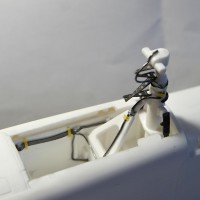Modelling early Wellesley Squadrons in 1/72
Most Wellesley models focus on the Second World War service in the middle east. Not so many actually represent the home squadrons which were equipped with the bomber before the war. The first squadron to get the Wellesley was No. 7 - however they were only holding them on trust for the reforming No. 76 Squadron and B flight was spun off from No. 7 to form the nucleus of No. 76. Others followed, Nos. 35, 77, 148 and 207.
The early Wellesleys were different. Firstly the tail profile was more rounded (which is something that neither Matchbox nor Valom modelled) and which is seen in the photo of K7725 of No. 76 Squadron above. The photo below of K7717 shows the later tail profile with the flattened crown which was introduced from the K85-- series aircraft (or second order). All previous Wellesleys up until K7791 had the early tail profile but some aircraft received the new tail profile as per K7717 (K7740 is another example). A bit of filing to both the leading and trailing edges of the fin is sufficient to represent this.
The next difference was the tailwheel spat. Fitted to early aircraft from K7713 up until K7739 it wasn't practical on grass airfields and would eventually be removed. However, it was a visible feature while it existed and was even present when later aircraft were constructed without it. Unfortunately there is no aftermarket available so the modeller needs to fabricate it themselves.
The final change to take note of was the rear canopy which is shown on this picture of K7771 and K7720 of No. 148 Squadron.
The Matchbox and Valom models have molded the rear canopy with a cutout which is correct for later aircraft. But once again the aircraft in the range K7713-K7739 were different and had no cutout - the rear edge of the canopy being unbroken. This is easy enough to represent - Falcon canopies do an excellent representation of this early canopy in their RAF Set No. 22 RAF Part 4.
Markings
Before Munich RAF bomber squadrons frequently carried the squadron number on their side and sometimes the individual aircraft letter. There was considerable variation here though. For the UK Wellesleys I've added a short list.
No. 7 Squadron - They only had the Wellesleys for less than a month and the likelihood of them receiving any specific markings is very low.
No. 35 Squadron - carried the squadron number in red with a thin black lining on the fuselage. The aircraft letter may have been in flight colours and could be lined.
No. 76 Squadron - carried the squadron number in red lined with yellow on the fuselage. No aircraft letter
No. 77 Squadron - carried the squadron number in medium sea grey and aircraft letter in the same colour
No. 148 Squadron - carried the squadron number in medium sea grey. No aircraft letter
No. 207 Squadron - No squadron number or aircraft letter
There are two Wellesley models in 1/72. The old Matchbox kit and the newer Valom kits. Matchbox combine the LRDU version with the standard version but actually have modelled K7717 the development aircraft not an LRDU aircraft. For an LRDU aircraft one needs the Valom kit (they were all L series aircraft). The Matchbox kit is a bit crude but surface representation of the geodesic construction is good and it forms the basis for a good model. The Valom kit is considerably more detailed but apparently is not easy to assemble. Surface detail is heavier in places particularly around the nose. In both kits the bomb aimers windows and glazing needs to be cut and fabricated. Both kits require a lot of work to make into a reasonable representation of an early Wellesley though I would go with the Matchbox kit which is still quite accurate.








What a great article, Christopher!
The Wellesley is an important part of aviation history, but not often seen modeled. Your article clarifies all necessary things, in order to come up with a great model.
Thanks for sharing!
Many thanks for the kind comments. I've always liked the aircraft since I was a child when I knew someone who flew them in the Red Sea during WW2.
Many thanks for this useful informative article, Christopher @christopher
It is still one of the aircrafts that I want to model, so this comes in very handy.
Welcome.
Many thanks for the kind comments.
What an interesting plane, never heard of it. Thank you!
My pleasure
Great article on a plane I've always liked. I built the Airframe vac kit back in the 70's. I keep hoping some limited run company does one in 1/48.
It will be a big model - the 1/72 version's wingspan is huge. Thanks for the kind comments